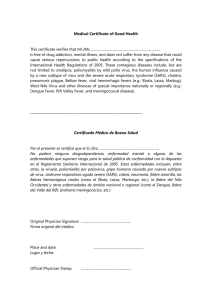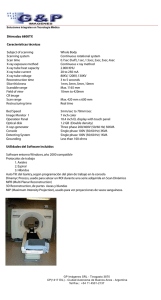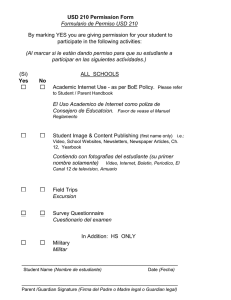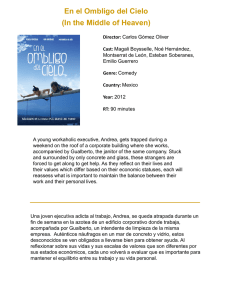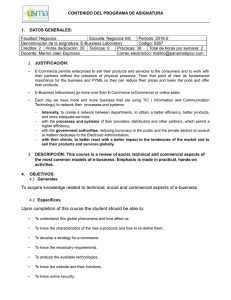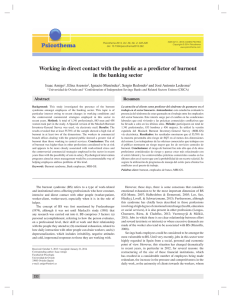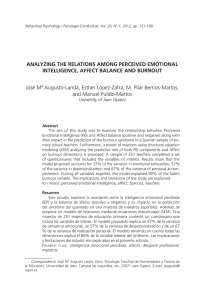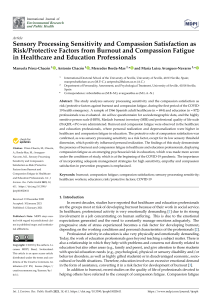Factor analysis of the “Questionnaire for the evaluation of
Anuncio
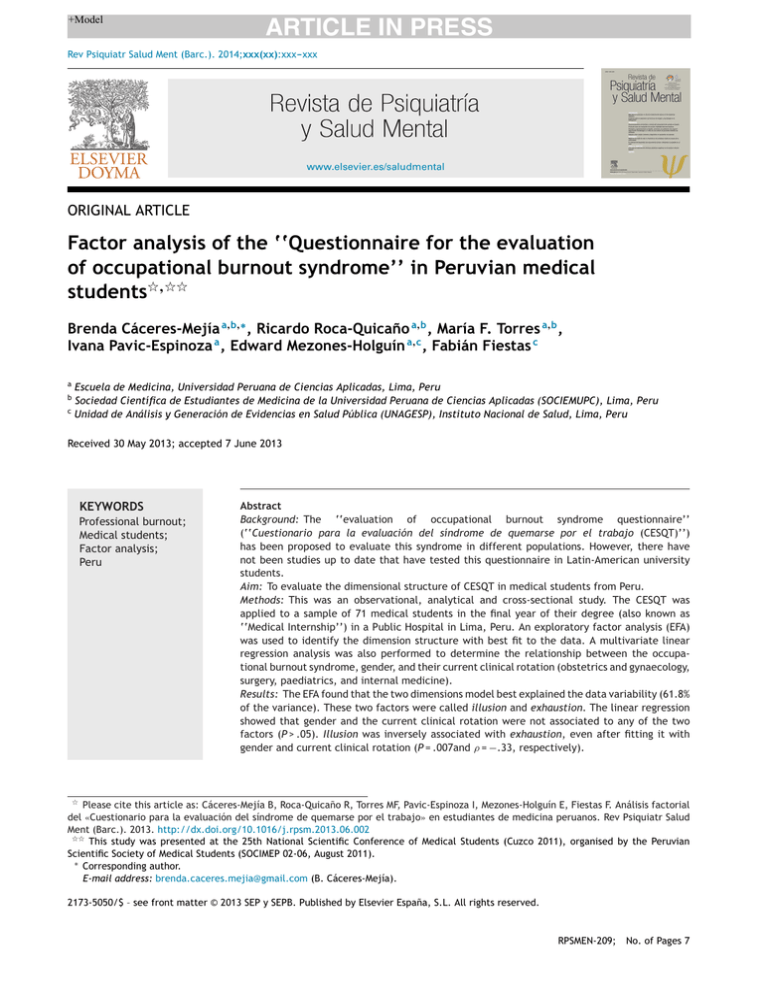
+Model ARTICLE IN PRESS Rev Psiquiatr Salud Ment (Barc.). 2014;xxx(xx):xxx---xxx www.elsevier.es/saludmental ORIGINAL ARTICLE Factor analysis of the ‘‘Questionnaire for the evaluation of occupational burnout syndrome’’ in Peruvian medical students夽,夽夽 Brenda Cáceres-Mejía a,b,∗ , Ricardo Roca-Quicaño a,b , María F. Torres a,b , Ivana Pavic-Espinoza a , Edward Mezones-Holguín a,c , Fabián Fiestas c a Escuela de Medicina, Universidad Peruana de Ciencias Aplicadas, Lima, Peru Sociedad Científica de Estudiantes de Medicina de la Universidad Peruana de Ciencias Aplicadas (SOCIEMUPC), Lima, Peru c Unidad de Análisis y Generación de Evidencias en Salud Pública (UNAGESP), Instituto Nacional de Salud, Lima, Peru b Received 30 May 2013; accepted 7 June 2013 KEYWORDS Professional burnout; Medical students; Factor analysis; Peru Abstract Background: The ‘‘evaluation of occupational burnout syndrome questionnaire’’ (‘‘Cuestionario para la evaluación del síndrome de quemarse por el trabajo (CESQT)’’) has been proposed to evaluate this syndrome in different populations. However, there have not been studies up to date that have tested this questionnaire in Latin-American university students. Aim: To evaluate the dimensional structure of CESQT in medical students from Peru. Methods: This was an observational, analytical and cross-sectional study. The CESQT was applied to a sample of 71 medical students in the final year of their degree (also known as ‘‘Medical Internship’’) in a Public Hospital in Lima, Peru. An exploratory factor analysis (EFA) was used to identify the dimension structure with best fit to the data. A multivariate linear regression analysis was also performed to determine the relationship between the occupational burnout syndrome, gender, and their current clinical rotation (obstetrics and gynaecology, surgery, paediatrics, and internal medicine). Results: The EFA found that the two dimensions model best explained the data variability (61.8% of the variance). These two factors were called illusion and exhaustion. The linear regression showed that gender and the current clinical rotation were not associated to any of the two factors (P > .05). Illusion was inversely associated with exhaustion, even after fitting it with gender and current clinical rotation (P = .007and = −.33, respectively). 夽 Please cite this article as: Cáceres-Mejía B, Roca-Quicaño R, Torres MF, Pavic-Espinoza I, Mezones-Holguín E, Fiestas F. Análisis factorial del «Cuestionario para la evaluación del síndrome de quemarse por el trabajo» en estudiantes de medicina peruanos. Rev Psiquiatr Salud Ment (Barc.). 2013. http://dx.doi.org/10.1016/j.rpsm.2013.06.002 夽夽 This study was presented at the 25th National Scientific Conference of Medical Students (Cuzco 2011), organised by the Peruvian Scientific Society of Medical Students (SOCIMEP 02-06, August 2011). ∗ Corresponding author. E-mail address: [email protected] (B. Cáceres-Mejía). 2173-5050/$ – see front matter © 2013 SEP y SEPB. Published by Elsevier España, S.L. All rights reserved. RPSMEN-209; No. of Pages 7 +Model ARTICLE IN PRESS 2 B. Cáceres-Mejía et al. Conclusion: The information included in the CESQT is summed up in two highly correlated dimensions: illusion and exhaustion that are independent gender and the current clinical rotation in which the students were involved. © 2013 SEP y SEPB. Published by Elsevier España, S.L. All rights reserved. PALABRAS CLAVE Agotamiento profesional; Interno; Análisis factorial; Perú Análisis factorial del «Cuestionario para la evaluación del síndrome de quemarse por el trabajo» en estudiantes de medicina peruanos Resumen Introducción: El «Cuestionario para la evaluación del síndrome de quemarse por el trabajo» (CESQT) fue propuesto para evaluar este síndrome en diversas poblaciones, sin embargo, no ha sido utilizado en estudiantes universitarios en Latinoamérica. Objetivo: Evaluar la estructura dimensional del CESQT en una población de estudiantes de medicina peruanos. Material y métodos: Estudio observacional, analítico de corte transversal en una muestra de 71 estudiantes de medicina que cursaban el último año de la carrera (interno médico) en un hospital público en Lima, Perú. Se desarrolló un análisis factorial exploratorio para establecer la estructura de las dimensiones con mejor ajuste a los datos. Posteriormente, se realizó un análisis de regresión lineal múltiple para explorar la asociación entre síndrome de quemarse por el trabajo con el sexo y la rotación clínica en la que se encontraban (ginecología-obstetricia, cirugía, pediatría y medicina interna). Resultados: El análisis factorial exploratorio encontró que el modelo con 2 dimensiones explicaba mejor la variabilidad de los datos (61,8% de la varianza). Estas 2 dimensiones se denominaron desgaste e ilusión. La regresión lineal mostró que el sexo y la rotación clínica actual no estuvieron asociados a ninguna de estas dimensiones (p > 0,05). La ilusión estuvo inversamente asociada al desgaste, inclusive después de ajustar por sexo y rotación clínica actual (p = 0.007; = −0,33). Conclusión: La información contenida en el CESQT se resume en 2 dimensiones altamente correlacionadas: ilusión y desgaste. Esta estructura es establecida independientemente del sexo y la rotación clínica que cursaban los alumnos. © 2013 SEP y SEPB. Publicado por Elsevier España, S.L. Todos los derechos reservados. Introduction Burnout syndrome (BS), a syndrome of work-related exhaustion and strain, is recognised as a response to occupational stress from which professionals from different fields, having direct contact with people, might find themselves suffering.1 Different instruments have been used for measuring this, which has brought about several definitions for this condition.1---3 Even though Freudenberger described BS symptomatology for the first time in 1973,4 Maslach and Jackson (1981) were the ones to construct the first instrument for measuring it: the Maslach Burnout Inventory (MBI).5 These authors also generated a new version (1986), in which BS was explained as a phenomenon characterised by 3 dimensions: low personal realisation in work (8 items), emotional exhaustion (9 items) and de-personalisation (5 items).6 Finally, they proposed 3 versions for different populations (1996): the MBI-Human Services Survey (MBI-HSS) for healthcare professionals, the MBI-Educators (MBI-ES) for education professionals and the MBI-General Survey (MBI-GS) for people from other professions (apart from healthcare and education).7 Despite the fact that the MBI had obtained broad international acceptance, with evidence for its concurrent and divergent validity, as well as empirical support for the factorial structure, it has been found to show some deficiencies. This is especially evident when it is adapted to other languages, such as Spanish. These deficiencies include: little reliability in some of its dimensions, the fact that some items present factor loading greater than 0.4 in certain dimensions, the lack of a discriminant validity with related concepts such as depression and limited access to the MBI due to its commercial use.8,9 Other instruments have been created to measure BS, such as the Oldenburg Burnout Inventory (OLBI), developed by Demerouti et al. in Germany in 200110 and the Burnout Syndrome Evaluation Questionnaire (CESQT in Spanish), developed by Gil-Monte in Spain in 2006.1 The latter has been used in several studies carried out in Spanishspeaking countries, such as Spain,11 Argentina,12 Mexico13---15 and Chile.16,17 It is important to mention that the CESQT differs from the MBI, as it has 4 dimensions: enthusiasm for work, psychological strain, indolence and guilt.1 Presently, there are no publications that have used the CESQT in Peru. However, studies have been carried out with Peruvian medical students using the MBI-HSS, where a 57.2% prevalence was found in students that studied internal medicine, which corresponded to the last year of medical studies, in which preprofessional practices are developed.18 This stage lasts 12 months and consists of 4 rotations: paediatrics, surgery, internal medicine and obstetrics and gynaecology (OBGYN). The population that finishes this +Model ARTICLE IN PRESS Questionnaire for the evaluation of occupational burnout syndrome training programme could potentially be at a greater risk for developing BS as they suffer from continuous academic stress while in permanent contact with other people.19 In addition, there is literature that supports the presence of this syndrome, called academic burnout syndrome, in university students, especially those in medicine and nursing programmes.19 The prevalence of this syndrome oscillates between 1.9% and 55.3%, with the variation dependent on the populations studied and instruments used.20---24 These findings suggest the possibility that this syndrome is developed pre-graduation in health science professionals.19 Given all the aforementioned information, we considered assessment of the presence of BS in Peruvian medical interns to be relevant. However, we did not find any literature with respect to instruments validated in Peruvian medical students, which impeded our ability to carry out direct measurements. Consequently, we needed to count on scales to reach this objective. The present study was carried out with the objective of evaluating the properties and dimensional structure of the CESQT in a medical intern population as a part of the process to have locally validated instruments and to perform studies related to BS in Peru. Materials and methods 3 indolence. After acknowledging this, whether the individual presents a high score in the guilt dimension is also determined. Other variables Sex (male or female) and clinical rotation (surgery, OBGYN, internal medicine or paediatrics) were also measured at the time of the interview. Procedures A list of names for each of the medical interns was generated. A database was then created where the participants’ names were replaced by codes, which were also used in the questionnaires. Later, the students were categorised by the department of their corresponding clinical rotation. Participation in the study was voluntary. The questionnaires were selfadministered, and participants were informed of the study objectives and were oriented on the correct completion of the questionnaires beforehand. The average completion time was 15 min. Three researchers were trained to resolve the doubts raised while the questionnaire was being completed. Quality control was performed afterwards, during the digitisation of the data. Study design and population Ethical aspects We performed a transversal study of all the medical students (n = 88) that did their medical internship in a public hospital in Lima, during their last clinical rotation in December of 2010. Measurements Burnout syndrome evaluation questionnaire The CESQT used was not modified in any way with respect to the original version.24 As mentioned previously, the CESQT is composed of 20 items that assess 4 dimensions1 : • Enthusiasm for work (5 items): individual desire to reach occupational goals because they represent a source of personal achievement. • Psychological strain (4 items): appearance of emotional and physical exhaustion due to having to treat people that present or cause problems on a daily basis at work. • Indolence (6 items): appearance of negative attitudes, indifference and cynicism. • Guilt (4 items): appearance of feelings of guilt for the behaviour and negative attitudes developed at work, especially towards people with whom professional relationships have been established. The items explore the frequency with which the person surveyed presents different situations, using a Likert scale, where 1 is never, 2 is a few times per year, 3 is a few times per month, 4 is a few times per week and 5 is everyday. On the CESQT, BS is defined as a low score in enthusiasm for work and high scores on psychological strain and The study was evaluated and approved by the Research and Ethics Committee at the level III public hospital where the study was performed. Participation was voluntary through verbal consent after the objectives of the study were explained. The questionnaire was anonymous, confidential and provided an informative cover page. Statistical analysis Descriptive level At the descriptive level, absolute and relative frequencies were reported for the categorical variables. Means and standard deviation were calculated for the numeric variables. Exploratory factor analysis An exploratory factor analysis (EFA) was performed to establish the dimensional structure present in the CESQT data obtained from the sample. Principal component analysis was used, as well as orthogonal rotation, in order to derive uncorrelated dimensions. With respect to the number of dimensions, several models were evaluated (from 2 to 6 dimensions), including components with eigenvalues greater than 1. The component that described the different patterns of BS with greater parsimony was selected, according to the researchers’ judgements and theoretical aspects of BS. After selecting the best factorial model, internal consistency was measured for each of the resulting dimensions using Cronbach’s alpha. ARTICLE IN PRESS 1.0000 −0.0331 1.0000 −0.0042 0.4025 1.0000 −0.1367 0.3042 0.3465 1.0000 −0.0151 0.2568 0.3001 0.2311 1.0000 0.4803 0.0157 −0.0686 −0.2035 −0.2728 1.0000 −0.0439 0.4567 0.4788 0.2533 0.3016 −0.1625 1.0000 −0.0879 −0.0954 0.1279 0.6036 0.3462 −0.1773 0.2274 1.0000 −0.2166 0.2161 0.5058 0.4239 0.4298 −0.2363 0.469 0.375 1.0000 0.1957 0.3923 0.4878 0.1302 0.1431 −0.0616 0.5434 0.0142 0.3078 1.0000 0.4585 −0.2394 −0.2604 −0.2743 −0.151 0.5823 −0.1397 −0.1873 −0.3537 −0.1131 1.0000 0.0492 0.2105 0.1248 0.0571 0.3565 −0.1255 0.3149 0.2234 0.3417 0.0955 −0.182 1.0000 0.0509 0.1743 0.4066 0.6456 0.1981 0.0414 0.2594 0.5208 0.3994 0.2417 −0.107 0.2777 1.0000 −0.1844 0.1158 0.3929 0.5639 0.1721 −0.1772 0.3953 0.5143 0.4459 0.2812 −0.256 0.1797 0.613 1.0000 0.3173 −0.0788 −0.0338 −0.2537 −0.2567 0.3526 −0.0546 −0.171 −0.1433 0.038 0.4983 −0.0273 −0.1641 −0.3476 1.0000 0.0646 0.2677 0.268 0.1544 0.3871 −0.0675 0.333 0.303 0.3767 0.3144 −0.0389 0.6251 0.3027 0.3438 −0.0797 1.0000 −0.0745 0.1046 0.1603 −0.0261 0.4017 −0.2157 0.019 0.1763 0.1795 0.2413 −0.109 0.3398 0.1751 0.1258 −0.1388 0.4502 1.0000 0.1326 −0.1482 0.3424 0.4697 0.2633 0.1866 −0.2631 0.487 0.1465 0.2925 0.3421 −0.1965 0.1731 0.2873 0.3244 −0.0285 0.2663 Q.: question. Q. 20 Q. 19 Q. 18 Q. 16 Q. 15 Q. 14 Q. 13 Q. 12 Q. 11 Q. 10 Q. 9 Q. 8 Q. 7 Q. 6 Q. 5 Q. 4 Q. 3 Q. 2 Correlation between items. Q. 1 1.0000 −0.2402 −0.3047 −0.2753 0.4423 −0.0324 −0.2806 −0.1179 −0.0816 0.5269 −0.2166 −0.2018 −0.2196 −0.1835 0.4802 −0.1173 −0.1734 −0.3641 0.3472 −0.1502 Table 1 Of the total 88 students who did their internship, 3 did not accept participation and 3 were not found during the questionnaire administration time. Consequently, 82 students were surveyed, but only 71 participants were included in the analysis, as 11 did not complete the questionnaires correctly. Of all the students surveyed, a little more than half were male. In addition, 22 were on surgical rotation, 22 on internal medicine, 15 on paediatrics and 12 on OBGYN. A correlation analysis was performed between the 20 items on the scale. As observed in Table 1, there are some that were directly related on a consistent basis, while others were inversely related. Pearson’s correlation coefficient was found to be between 0.014 and 0.645 for the direct correlations, while it was between −0.004 and −0.364 for the inverse correlations. The EFA is presented in Table 2, in which the model with 2 dimensions was found to explain 61.8% of variability in the data. This model grouped the items parsimoniously and with theoretical significance. These dimensions were called professional strain and enthusiasm for work. The first dimension included 3 of the domains identified in the original version of the CESQT: indolence, guilt and professional strain. The strain dimension consisted of items 2, 3, 4, 6, 7, 8, 9, 11, 12, 13, 14, 16, 17, 18 and 20. The values obtained varied from 5 to 38, with a mean of 21.59, standard deviation (SD) of 8.0 and a median of 21. The 75th percentile showed a cut-off point of 27 on the scale, which would be the people with greater symptomatology of strain from work. The enthusiasm dimension consisted of questions 1, 5, 10, 15 and 19. The values obtained varied from 9 to 20, with a mean of 15.8, SD of 3 and median of 16. The 25th percentile showed a cut-off point of 14 on the scale, and consisted of 14 people. For the strain dimension, Cronbach’s alpha was 0.85. After considering the alpha without 1 of the items, reliability varied between 0.83 and 0.86. With respect to the enthusiasm dimension, Cronbach’s alpha was 0.8, and reliability varied between 0.73 and 0.8 after considering the alpha without 1 of the items. In general, all these results suggest that the questions have a good level of reliability in each of the dimensions. In addition, we found that the strain dimension was inversely correlated with the enthusiasm dimension. However, this correlation is weak (P = −.33). For greater exploration of the association between these 2 dimensions, a simple and multiple linear regression analysis was performed to consider the potential effect that sex and clinical rotation had on this association. We found that enthusiasm had a significant inverse association with the strain dimension. Q. 17 Results 1 2 3 4 5 6 7 8 9 10 11 12 13 14 15 16 17 18 19 20 Linear regression Finally, the association between each of the dimensions and the sex and clinical rotation variables was evaluated using simple and multiple linear regression models. The objective was to explore whether any of these BS dimensions varied with respect to sex and clinical rotation. 1.0000 B. Cáceres-Mejía et al. 1.0000 0.4667 0.0458 −0.0708 0.0752 0.4944 0.2436 0.0853 −0.2278 0.2204 0.1626 0.3355 0.0974 −0.223 −0.0275 0.3459 0.312 −0.0084 0.0674 4 Q. Q. Q. Q. Q. Q. Q. Q. Q. Q. Q. Q. Q. Q. Q. Q. Q. Q. Q. Q. +Model +Model ARTICLE IN PRESS Questionnaire for the evaluation of occupational burnout syndrome Table 2 5 Matrix of factorial patterns and variances. Item 1 2 Variance Alpha without item 1. Work challenge 2. No cooperation 3. Intolerable patients 4. Worry about treating people 5. Personal achievement 6. Burden 7. Indifferent 8. Saturated 9. Guilty 10. Positive things 11. Irony 12. Overwhelmed 13. Remorse 14. Labelling 15. Gratifying work 16. Asking forgiveness 17. Physical tiredness 18. Emotional tiredness 19. Enthusiasm 20. Things said poorly −0.205 0.368 0.528 0.312 0.093 0.502 0.681 0.526 0.472 −0.069 0.679 0.437 0.626 0.588 −0.165 0.475 0.647 0.581 −0.069 0.616 0.627 −0.240 −0.193 −0.152 0.665 0.039 −0.099 −0.328 −0.172 0.744 −0.051 −0.311 −0.290 0.112 0.733 −0.020 −0.115 −0.363 0.576 0.022 0.565 0.808 0.684 0.880 0.549 0.746 0.527 0.616 0.748 0.443 0.537 0.713 0.524 0.642 0.436 0.774 0.568 0.531 0.663 0.620 0.758 0.847 0.839 0.856 0.769 0.846 0.834 0.837 0.842 0.741 0.835 0.842 0.834 0.843 0.726 0.843 0.831 0.832 0.797 0.838 This association was maintained even after adjusting for the 2 variables mentioned (P = .007). Furthermore, the linear regression model showed that neither the sex nor present clinical rotation variables were associated with strain or enthusiasm (Table 3). Discussion The principal findings in our study showed that the 2dimensional model was best adjusted to our sample (enthusiasm for work and professional strain). This structure was established independently of sex and present clinical rotation. Likewise, the entire questionnaire, as well as each dimension, showed Cronbach’s alpha to be higher than 0.7; this indicates that the instrument presents adequate internal consistency. This finding has important implications, as it contributes to the factorial validity of this questionnaire and suggests that its functioning in populations of Peruvian medical Table 3 Factors associated with each of the components. ˇ 95% CI P Strain Enthusiasm Sex Present rotation −0.87 1.28 −0.18 −1.495 to −0.248 −2.376 to 4.929 −1.835 to 1.473 0.007 0.488 0.828 Enthusiasm Strain Sex Present rotation −0.12 0.29 0.34 −0.205 to −0.034 −1.068 to 1.643 −0.269 to 0.945 0.007 0.673 0.270 Results obtained from multivariate analysis. students in their last year of study could be different from that shown in other countries where it has been validated previously. Specifically, our study showed that CESQT behaviour in Peruvian medical students had 2 dimensions, while in other populations, such as in Spain,1,11 Argentina,12 Mexico13---15 and Chile,16,17 the questionnaire showed 4. In the EFA of the CESQT prepared by Gil-Monte, the 4dimensional model was found to explain 60.9% total variance (factor loading was considered to be greater than 0.35 for it to pertain to each factor). In relation to our study, the 2-dimensional model was the one that best adjusted to the data obtained (a factor loading greater than 0.4 was used for the item to pertain to each factor); this model explained 61.8% of the variance, which is slightly better than the variance explained by the previously mentioned 4-dimensional model.11 In the initial validation, Gil-Monte found that internal consistency (measured using Cronbach’s alpha) ranged between 0.79 and 0.86 on the 4 dimensions, with the indolence dimension being the lowest. This aspect was different from that found in our study, where enthusiasm was found to have the lowest Cronbach’s alpha (0.79). This could be because the strain dimension in our study included the questions corresponding to the 3 dimensions in CESQT found in previous studies (indolence, guilt and psychological strain). Meanwhile, the enthusiasm dimension in our study contained the same questions as its corresponding dimension in the 4-dimensional structure.1 It is relevant to consider the socio-cultural differences of the sample used in the 2 studies, as this might explain the differences found in the analysis. The Gil-Monte study used a sample of 201 nursing professionals, who had a mean of 17 years of work experience,1 while our study +Model ARTICLE IN PRESS 6 used a sample of participants in their first year of hospital intern work. This could explain the differences regarding performance of the questionnaire when considering the 2dimensional model, which, in our study, better explains the data found. It is important to mention that this has been the first opportunity, in Peru, to explore BS with medical interns by using the CESQT. In addition, the questionnaire was applied at a strategic moment of the internship, as it was administered in the final days. This allowed for better performance from the student, given that the probabilities of having BS are associated with greater time of exposure.19 However, there are some limitations in the present study. The entire sample came from only 1 hospital institution selected based on convenience, and there was a high rate of non-participation (around 40%). Both of these aspects reduce the possibility of generalising the results to other professional healthcare fields in Peru. In this sense, future studies that include greater variability of participants are needed, making it possible to obtain a valid instrument that helps in the study of burnout syndrome among the population of healthcare professionals in the country. Our findings represent information that could be taken into account for the design and implementation of these future studies. In conclusion, the information contained in the CESQT is summarised in 2 highly correlated dimensions (enthusiasm and strain), which are independent of sex and the clinical rotation performed by the medical students doing their medical internship. Ethical disclosures Human and animal protection. The authors declare that no experiments were performed with humans or animals for this study. Data confidentiality. The authors declare that no participant data appear in this study. Right to privacy and informed consent. The authors declare that no participant data appear in this study. Conflicts of interest The authors have no conflicts of interest to declare. Acknowledgements We would like to thank Doctor Pedro Gil-Monte for providing the instrument to obtain the data, as well as Sofía Chávez Meneses, Ángela Leiva Montejo and Gustavo León Amenero for giving support for the pilot study preparation. References 1. Gil-Monte P. Evaluación psicométrica del síndrome del burnout: el cuestionario CESQT. In: Garrido J, editor. ¡Maldito trabajo!. Barcelona: Granica; 2008. p. 269---91. B. Cáceres-Mejía et al. 2. Hernández TJ, Terán OE, Navarrete DM, León A. El síndrome de burnout: una aproximación hacia su conceptualización, antecedentes, modelos explicativos y de medición. Rev Int Nueva Gest Organ. 2007;5:50---68. 3. Demerouti E, Bakker AB, Janssen PPM, Schaufeli WB. Burnout and engagement at work as a function of demands and control. Scand J Work Environ Health. 2001;27:279---86. 4. Wessells DT. Professional burnout in medicine and the helping professions. New York: The Haworth Press; 1989. 5. Maslach C, Jackson S. The measurement of experienced burnout. J Organ Behav. 1981;2:99---113. 6. Maslach C, Jackson SE. Maslach burnout inventory: manual. CA: Consulting Psychologists Press; 1986. 7. Maslach C, Jackson SE, Leiter MP. Maslach burnout inventory. CA: Consulting Psychologist Press; 1996. 8. Alvarado K. Validez factorial de Maslach Burnout Inventory (Versión Castellana) en educadores costarricenses. Rev Actual Investig Educ. 2009;9:1---22. 9. Olivares VE, Gil-Monte PR. Análisis de las principales fortalezas y debilidades del Maslach Burnout Inventory (MBI). Cienc Trab. 2009;11:160---7. 10. Demerouti E, Bakker A. The Oldenburg Burnout Inventory: a good alternative to measure burnout and engagement. In: Halbesleben J, editor. Handbook of stress and burnout in health care. New York: Nova Science Publishers; 2008. 11. Gil-Monte PR, García-Juesas JA, Núñez E, Carretero N, Roldán MD, Caro M. Validez factorial del Cuestionario para la evaluación del síndrome de quemarse por el trabajo (CESQT). Interpsiquis. 2006;10:1---9. 12. Marucco MA, Gil-Monte PR, Flamenco E. Síndrome de quemarse por el trabajo (burnout) en pediatras de hospitales generales, estudio comparativo de la prevalencia medida con el MBI-HSS y el CESQT. Inform Psicol. 2007;91---92: 32---42. 13. Gil-Monte PR, Unda S, Sandoval JI. Validez factorial del Cuestionario para la evaluación del síndrome de quemarse por el trabajo (CESQT) en una muestra de maestros mexicanos. Salud Ment. 2009;32:205---14. 14. Gil-Monte PR, Zúñiga-Caballero LC. Validez factorial del Cuestionario para la evaluación del síndrome de quemarse por el trabajo (CESQT) en una muestra de médicos mexicanos. Univ Psychol. 2010;9:169---78. 15. Gil-Monte PR, Noyola VS. Estructura factorial del Cuestionario para la evaluación del síndrome de quemarse por el trabajo en maestros mexicanos de educación primaria. Rev Mex Psicol. 2011;28:75---84. 16. Olivares V, Gil-Monte PR. Análisis de las propiedades psicométricas del Cuestionario para la evaluación del síndrome de quemarse por el trabajo (CESQT) en profesionales chilenos. Ansiedad Estrés. 2007;13:229---40. 17. Olivares V, Vera A, Juarez A. Prevalencia del síndrome de quemarse por el trabajo (burnout) en una muestra de profesionales que trabajan con personas con discapacidades en Chile. Ciencia Trabajo. 2009;32:63---71. 18. Estela-Villa L, Jiménez-Román C, Landeo-Gutiérrez J, TomateoTorvisco J, Vega-Dienstmaier J. Prevalencia de síndrome de burnout en alumnos del séptimo año de medicina de una universidad privada de Lima, Perú. Rev Neuropsiquiatr. 2010;73:147---56. 19. Caballero C, Hederich Ch, Palacio J. El burnout académico: delimitación del síndrome y factores asociados con su aparición. Rev Latinoam Psicol. 2010;42:131---46. 20. Dyrbye L, Thomas M, Huntington J, Lawson K, Novotny P, Sloan J, et al. Personal life events and medical student burnout: a multicenter study. Acad Med. 2006;81:374---84. 21. Dyrbye L, Stanford F, Eacker A, Harper W, Power D, Durning S, et al. Relationship between burnout and professional +Model ARTICLE IN PRESS Questionnaire for the evaluation of occupational burnout syndrome conduct and attitudes among US medical students. JAMA. 2010;304:1173---80. 22. Rosen I, Gimotty P, Shea J, Bellini L. Evolution of sleep quantity, sleep deprivation, mood disturbances, empathy, and burnout among interns. Acad Med. 2006;81:82---5. 7 23. Willcock S, Daly M, Tennant CH, Allard B. Burnout and psychiatric morbidity in new medical graduates. Med J Aust. 2004;181:357---60. 24. Gil-Monte P. CESQT. Cuestionario para la evaluación del síndrome de quemarse por el trabajo. Madrid: TEA Ediciones; 2011.
